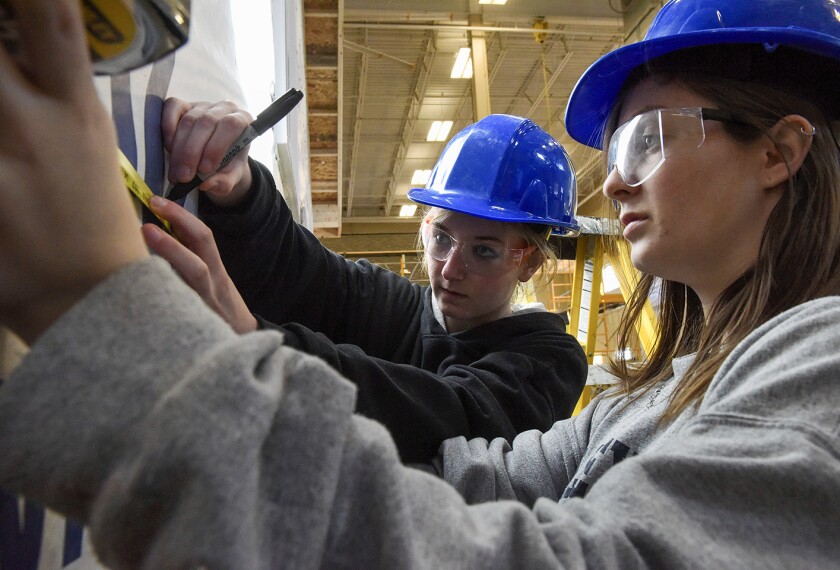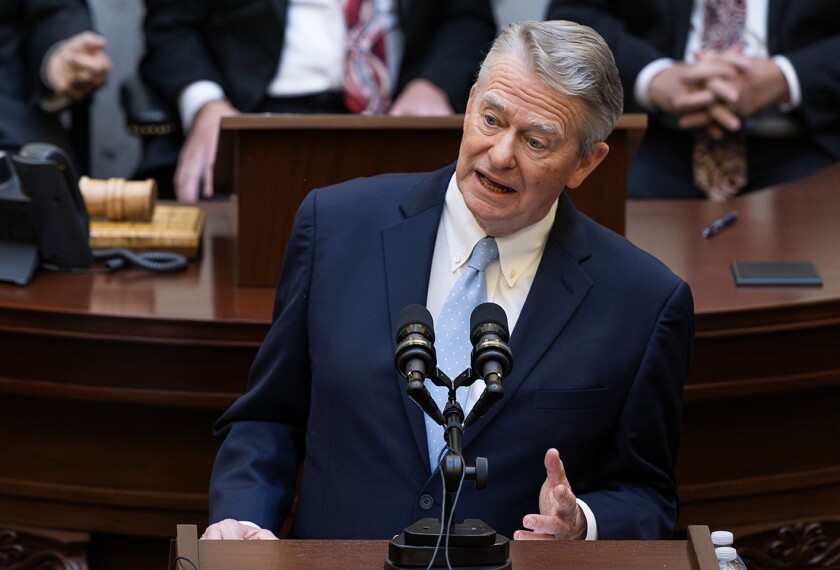Oklahoma
Okla. Governor Vows School Fund Hike Despite Shortfall
Even though Oklahoma is facing a $600 million budget shortfall for the coming fiscal year, the state’s new Democratic governor proposed increasing education spending by $110 million in fiscal 2004 in his recent State of the State Address.

“We will cut administrative costs,” Gov. Brad Henry said in his Feb. 3 address. “But above all we will protect the classroom.”
Such a plan will be difficult, said Keith Ballard, the executive director of the Oklahoma State School Boards Association. “But I think it is feasible,” he said.
Gov. Henry has asked all state agencies to implement “zero-based budgeting,” which means that they need to justify every dollar in their budgets instead of using previous budgets as a base.
“We favor long-term solutions over short-term Band Aids,” said the governor, who also used the State of the State speech to propose creating an education lottery in his Bible Belt state.
Many Republicans, who are now in the minority in the legislature, agree with zero-based budgeting and putting education first, said Rep. Larry Ferguson, a Republican who serves on the House education committee.
“These are all things that either myself or members of my caucus have advocated for many years,” he said.
But finding support for a $110 million hike to the current $1.8 billion public education budget may prove tricky for the governor.
“We have yet to see where he has come up with any money,” Mr. Ferguson said. “It is one of these robbing-Peter- to-pay-Paul-type things, and unfortunately neither one of them wants to get robbed.”
Gov. Henry, who defeated then-U.S. Rep. Steve Largent, a Republican, at the polls last November, also proposed that the legislature call a referendum on creating an education lottery.
Lottery Questions
Such a lottery, he said, would provide more than $300 million in new money for education—money that could not be found through budget cuts alone. “We cannot economize our way to excellence,” he said.
Oklahoma currently has no state lottery. Proceeds from an education lottery would go to initiatives such as upgrading technology in rural schools, developing incentives for parental involvement, creating more early-childhood programs, and sending qualified students to college tuition-free, the governor said.
“In the end, we’ll have a built-in revenue stream to enhance education,” he said.
But creating a state lottery is a controversial idea in Oklahoma, Mr. Ferguson said. “Some people call Oklahoma the buckle of the Bible belt,” he said, adding that religious activists have been outspoken in their opposition to lotteries.
But, Mr. Ferguson said, “I think we have to stop and realize that maybe people want to vote on it.”
Gov. Henry also encouraged the legislature to pass his Oklahoma Partnership for School Readiness Act, which, he said, would help identify young children at risk for academic failure by encouraging public-private partnerships that focus on high- quality child care and early education programs. The governor also proposed targeted tax relief for teachers who spend their own money to buy supplies for their classrooms.
Alaska
Murkowski Says Schools
Will Face Challenges
Even as he foresees a future of fiscal sacrifice, newly elected Gov. Frank H. Murkowski is pledging to support regional education centers, distance learning, and other efforts to help students in the remote, hard-to-serve schools in his state.
The Republican governor, who took office Dec. 2, said Alaska will face daunting challenges in trying to meet the requirements of the federal “No Child Left Behind” Act of 2001, in his State of the State Address last month.
In particular, the law’s mandates on finding qualified teachers for small schools in rural areas, where new teachers typically face major cultural adjustments, will be especially difficult, he said in the Jan. 23 speech. But Gov. Murkowski said regional learning centers and distance learning can be used to help students in rural districts and to provide necessary training for teachers and paraprofessionals.
Alaska faces a budget deficit of $896 million in fiscal 2004, according to some estimates. Gov. Murkowski, a former U.S. senator, vowed that he would control spending, even if it meant “unpopular choices.”
“We will be asking all Alaskans to make sacrifices for the mutual, long-term good,” Gov. Murkowski told lawmakers.
He also promised to search for new sources of revenue, by increasing oil production, pushing for new timber development, and aggressively seeking to increase activity in other industries.
Gov. Murkowski’s administration is considering ways to develop regional learning centers that allow students from different school districts to attend more- centralized facilities, according to his spokesman, John Manly. The centers would offer students better classroom opportunities and reduce the costs of maintaining myriad small schools, Mr. Manly said. Many elements of the proposal have yet to be made final, the spokesman added.
The new governor replaces Tony Knowles, a Democrat whose final years in office were marked by feisty scraps with the GOP-controlled legislature over the budget. Gov. Murkowski would probably submit his fiscal 2004 budget in the next few weeks, Mr. Manly said, and like other areas of government, K-12 education is facing the possibility of cuts. “The costs of everything are going up,” Mr. Manly said. “Where we’re going to find additional funding is really a tough question.”
—Sean Cavanagh
Michigan
Granholm Vows to Protect
Schools During ‘Crisis’
In her inaugural State of the State Address, Gov. Jennifer Granholm pronounced Michigan healthy in spirit if not in pocketbook and pledged to “educate our children ... despite the budget crisis.”
The Democratic chief executive, who follows three-term Republican Gov. John Engler into office, noted briefly in her Feb. 5 speech that state law obliges her to cut the education budget because of a $127 million shortfall in the school aid fund. But Ms. Granholm then turned quickly to her plans to improve learning in ways that don’t cost additional money.
Stressing the critical importance of the early years, the governor held up the twin goals of educating new parents and making sure preschoolers are read to each day for half an hour. She said she would call for greater cooperation among state and educational agencies to reach those goals.
She said she plans to team high school students with preschool centers to make sure children are read to daily. At the same time, she proposed that school districts voluntarily adopt a requirement that high school students perform 40 hours of community service in order to graduate.
Ms. Granholm used her speech to announce a new approach to higher education scholarships that emphasizes financial need and desire rather than prior achievement. Starting with private money but perhaps expanding to state funds when revenues improve, $2,000 scholarships will be guaranteed to current middle school students who ultimately pursue postsecondary education, she said. The governor also announced a private-public partnership to help expand online professional development opportunities for teachers.
Meanwhile, some lawmakers have proposed altering language on mandatory education cuts so that each district in Michigan suffers a 1 percent loss in total state aid. Under current state law, the governor must make automatic cuts that range from less than 1 percent for some districts to 3 percent for others, though they average 1 percent.
The reductions take effect this month, but could be adjusted later.
—Bess Keller
Minnesota
Pawlenty Targets Budget
In Address to Legislators
Gov. Tim Pawlenty has outlined an ambitious education agenda that includes dumping the state’s embattled learning standards and moving toward performance-based pay for teachers.
In his first State of the State Address, the newly elected Republican acknowledged, however, that his main preoccupation will be resolving Minnesota’s budget crisis. The state’s fiscal 2003 spending deficit of $356 million, out of a total budget of $13.9 billion, is projected to grow to $4.2 billion in 2004.
Still, the state that gave birth to the charter school movement and prides itself on educational excellence has “become complacent, and we’re treading water,” Mr. Pawlenty said in his Feb. 6 speech. “We need to reclaim our place as the best education innovators in the country.”
Mr. Pawlenty made certain points clear: He wants to replace the state’s system of standards-based education, called the Profile of Learning; he wants to redesign the state’s school funding formula to make it fairer and less complicated; and he wants some form of merit pay for teachers. (“Minnesota Scrambles to Revamp Standards,” this issue).
The governor also called on parents to take part in—and take charge of—their children’s educations and work with schools. For children whose parents don’t answer that call, Mr. Pawlenty said, the state must provide mentors and tutors. But he did not propose any specific programs.
He said his administration is committed to giving economically disadvantaged students more options. He didn’t offer details of how he plans to be “more creative” on their behalf, however.
—Darcia Harris Bowman




